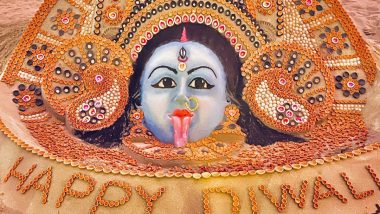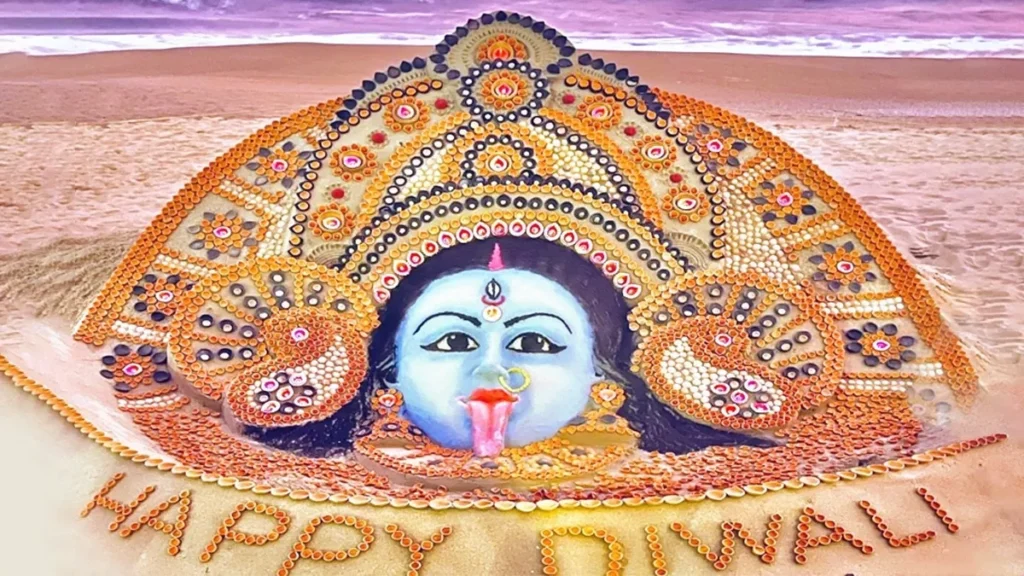Goddess Kali, known as the fierce and powerful deity in Hindu mythology, holds immense significance in various art forms across India. In the state of Odisha, the depiction of Goddess Kali in art is particularly prominent, with a special reference to the revered Shyamakali at Puri. Let us dive into the rich history and captivating artistic representation of Goddess Kali in Odisha.
Odisha, located on the eastern coast of India, is renowned for its vibrant culture, ancient temples, and unique art forms. The art of Odisha has been greatly influenced by the religious beliefs and practices of the people residing in the region. Amongst the numerous deities worshipped in the state, Goddess Kali holds an integral position.
Goddess Kali is often depicted as a fierce and wrathful deity, adorned with a garland of skulls, a protruding tongue, and multiple arms holding weapons and severed heads. She is said to emanate immense power and represents the force of Time as well as the destroyer of evil. In Odisha, the portrayal of Kali is distinctive, incorporating various regional elements and indigenous art techniques.
One of the most significant manifestations of Goddess Kali in Odisha art is the Shyamakali temple in Puri. Located near the famous Jagannath Temple, this ancient temple is dedicated to Goddess Shyamakali, a form of Goddess Kali. The temple dates back to the 17th century and is renowned for its exquisite architecture and unique sculptures.
The idol of Shyamakali at Puri is distinct from other depictions of Kali in India. Here, the goddess is represented with a calm and serene expression, in contrast to the fierce and wrathful image often associated with Kali. The idol is carved out of black stone and stands around eight feet tall. Devotees from far and wide visit the temple to seek the blessings of Shyamakali, believed to be a benevolent and compassionate form of Goddess Kali.

You can read our another post on Visnu and Radha Worship: Honoring Divine Love and Devotion
The artistic representation of Shyamakali at Puri is a testament to the highly skilled craftsmanship of Odisha’s artisans. The intricate carvings on the temple walls and pillars depict various mythological stories and scenes from the lives of gods and goddesses. The architecture of the temple showcases the distinct Odisha style, known for its elaborate carvings and ornate designs.
Apart from the Shyamakali temple, Odisha houses several other temples where the goddess is worshipped and revered. The most famous among them is the Taratarini Temple in Ganjam district. This temple is believed to be one of the ancient Shakti Peethas, where the goddess’s upper teeth fell during the construction of the universe. Thousands of devotees flock to this temple during the festive season to pay their respects to Goddess Kali.
The incorporation of Goddess Kali in Odisha art is not limited to temples alone. The art forms of Pattachitra and Chitrakathi, traditional paintings on cloth and palm leaf, respectively, often depict the goddess in their narratives. These paintings beautifully capture the distinctive attributes and symbolism associated with Kali, serving as a medium for storytelling and religious expression.
In conclusion, Odisha’s artistic representation of Goddess Kali, with a special mention of Shyamakali at Puri, truly reflects the unique cultural heritage and beliefs of the region. The serene yet powerful portrayal of the deity in art forms like temple architecture and traditional paintings showcases the deep reverence that the people of Odisha hold for Goddess Kali. It is through these artistic expressions that the devotion and faith towards the goddess are immortalized, enriching the heritage of Odisha’s art and culture.
More: Wanted to download Odishashop.com visit here

Write A FAQ For Goddess Kali in Odisha Art : With Special Reference to Shyamakali at Puri
What is the significance of Goddess Kali in Odisha art?
In Odisha art, Goddess Kali holds immense significance as she represents the fierce and powerful aspect of the divine feminine. She is seen as the annihilator of evil and protector of the devotees.
What is Shyamakali and why is it special in Puri?
Shyamakali is a specific form of Goddess Kali worshipped in the Jagannath temple in Puri, Odisha. It is believed to be an amalgamation of two deities – Goddess Kali and Maa Chamunda. Shyamakali is considered special in Puri as it is closely associated with Lord Jagannath, the presiding deity of the temple.
How is Shyamakali depicted in Odisha art?
Shyamakali is often depicted with a dark blue or black skin tone, wearing a garland of skulls and holding various weapons in her hands. She has a fierce expression on her face and is usually shown standing on Lord Shiva, symbolizing the victory of divine feminine over destructive forces.
What is the cultural significance of Shyamakali in Odisha?
Shyamakali is an integral part of the cultural fabric of Odisha. She is worshipped during various festivals and ritual ceremonies. The dance form called “Kali Tandav” is also dedicated to Shyamakali, where dancers portray the fierce and dynamic nature of the goddess through their movements.
Where can one find depictions of Shyamakali in Odisha art?
Depictions of Shyamakali can be found in various forms of Odisha art, including pattachitra (traditional cloth-based scroll painting), stone and wood sculptures, and temple architecture. Some temples specifically dedicated to Shyamakali can be found in Puri and other parts of Odisha, where devotees can worship and seek her blessings.
